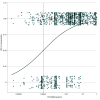Risk of Rabies and Implications for Postexposure Prophylaxis Administration in the US
- PMID: 37294570
- PMCID: PMC10257100
- DOI: 10.1001/jamanetworkopen.2023.17121
Risk of Rabies and Implications for Postexposure Prophylaxis Administration in the US
Abstract
Importance: In the US, rabies postexposure prophylaxis (PEP) is often administered without a comprehensive and regionally appropriate rabies risk assessment. For low-risk exposures, this can result in patients incurring out-of-pocket expenses or experiencing adverse effects of PEP unnecessarily.
Objective: To use a model to estimate (1) the probability that an animal would test positive for rabies virus (RABV) given that a person was exposed, and (2) the probability that a person would die from rabies given that they were exposed to a suspect rabid animal and did not receive PEP, and to propose a risk threshold for recommending PEP according to model estimates and a survey.
Design, setting, and participants: In this decision analytical modeling study, positivity rates were calculated using more than 900 000 animal samples tested for RABV between 2011 and 2020. Other parameters were estimated from a subset of the surveillance data and the literature. Probabilities were estimated using Bayes' rule. A survey was administered among a convenience sample of state public health officials in all US states (excluding Hawaii) plus Washington, DC and Puerto Rico to determine a risk threshold for PEP recommendation. Respondents were asked whether they would recommend PEP given 24 standardized exposure scenarios while accounting for local rabies epidemiology.
Main outcomes and measures: A quantitative and regionally appropriate approach for helping health care practitioners and public health professionals determine whether to recommend and/or administer rabies PEP.
Results: A total of 1728 unique observations were obtained from the model for the probability that an animal would test positive for RABV given that a person was exposed, and 41 472 for ) the probability that a person would die from rabies given that they were exposed to a suspect rabid animal and did not receive PEP. The median probability that an animal would test positive for RABV given that a person was exposed ranged from 3 × 10-7 to 0.97, while the probability that a person would die from rabies given that they were exposed to a suspect rabid animal and did not receive PEP ranged from 1 × 10-10 to 0.55. Fifty public health officials out of a target sample size of 102 responded to the survey. Using logistic regression, a risk threshold was estimated for PEP recommendation of 0.0004; PEP may not be recommended for exposures with probabilities below this threshold.
Conclusions and relevance: In this modeling study of rabies in the US, the risk of death|exposure was quantified and a risk threshold was estimated. These results could be used to inform the decision-making process as to the appropriateness of recommending rabies PEP.
Conflict of interest statement
Figures




Similar articles
-
Assessing rabies knowledge gaps in human and animal healthcare professionals practicing in Washington, DC-A one health approach.Zoonoses Public Health. 2018 Dec;65(8):947-956. doi: 10.1111/zph.12514. Epub 2018 Aug 11. Zoonoses Public Health. 2018. PMID: 30099849
-
Use of rabies postexposure prophylaxis supplied by the Alaska Section of Epidemiology, Alaska, 2002-2007.Public Health Rep. 2009 Mar-Apr;124(2):262-6. doi: 10.1177/003335490912400214. Public Health Rep. 2009. PMID: 19320368 Free PMC article.
-
Evaluating Surveillance for and Estimating Administration of Rabies Postexposure Prophylaxis in the United States, 2012-2018.PLoS Negl Trop Dis. 2021 Oct 25;15(10):e0009878. doi: 10.1371/journal.pntd.0009878. eCollection 2021 Oct. PLoS Negl Trop Dis. 2021. PMID: 34695115 Free PMC article.
-
Rabies postexposure prophylaxis: What the U.S. emergency medicine provider needs to know.Acad Emerg Med. 2023 Nov;30(11):1144-1149. doi: 10.1111/acem.14755. Epub 2023 Jun 14. Acad Emerg Med. 2023. PMID: 37245074 Review.
-
A review of the economics of the prevention and control of rabies. Part 1: Global impact and rabies in humans.Pharmacoeconomics. 1998 Oct;14(4):365-83. doi: 10.2165/00019053-199814040-00004. Pharmacoeconomics. 1998. PMID: 10344905 Review.
Cited by
-
Measuring the impact of an integrated bite case management program on the detection of canine rabies cases in Vietnam.Front Public Health. 2023 Oct 18;11:1150228. doi: 10.3389/fpubh.2023.1150228. eCollection 2023. Front Public Health. 2023. PMID: 37920576 Free PMC article.
References
-
- U.S. Centers for Disease Control and Prevention . How is rabies transmitted? Updated June 11, 2019. Accessed August 25, 2022. https://www.cdc.gov/rabies/transmission/index.html
MeSH terms
LinkOut - more resources
Full Text Sources
Medical
Miscellaneous

